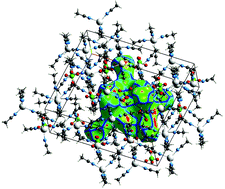True and quasi-isomorphism in tetrakis(acetonitrile)coinage metal(i) salts†
Abstract
Salts of the family [M(NCMe)4]+X− (M = Cu, Ag; X− = [BF4]−, [ClO4]−, [PF6]− crystallize in the space groups Pna21 or P212121 with very similar cell dimensions. This gives rise to two sets of true isomorphs (four members in Pna21, two in P212121), and a solvated species (Cu/PF6/MeCN) with a distorted P212121 lattice. Across the two space groups and regardless of the choice of metal atom or anion, the underlying basic structures are virtually identical in the six unsolvated cases, consisting of alternate sheets of cations and anions, mainly held together by C–H⋯C,N and C,N⋯C,N interactions, and a columnar cation–anion motif perpendicular to the sheets maintained by C–H⋯F,O interactions. The pair of concomitant polymorphs found with Cu/BF4 in both Pna21 and P212121 can readily be described as being quasi-isomorphous. Using a Hirshfeld surface approach and a tri-cationic structural synthon extracted from the asymmetric units, the common underlying pattern of close intercomponent approaches has been analysed and quantified. The structure of the Ag/PF6 complex is new; low-temperature redeterminations are recorded for the Ag/ClO4 and the Cu/PF6/MeCN complexes.


 Please wait while we load your content...
Please wait while we load your content...